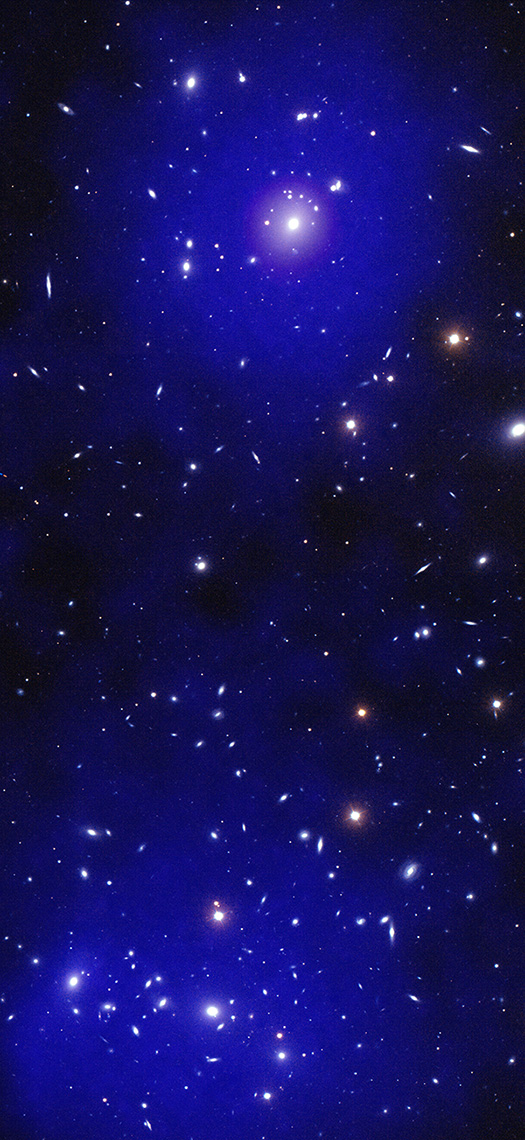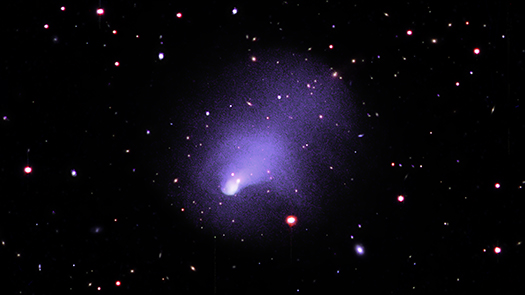Groups & Clusters of Galaxies
Powerful Yet Lonely: The Distant Quasar Left Alone in its Group
We are happy to welcome Valentina Missaglia as a guest blogger. She is the first author of the paper that is the subject of our latest press release. She is currently a postdoctoral researcher at the Institute of Astrophysics — FORTH in Heraklion (Crete) in the SMILE (“Search for Milli-LEnses”) group, recently funded by an ERC grant, that aims at investigating the nature of dark matter through observations of gravitational lenses on milli-arcsecond scales. Valentina earned her Ph.D. from the University of Turin (Italy) and her research focuses on radio and X-ray emission from radio-loud active galactic nuclei (which contain supermassive black holes that are rapidly pulling in material, producing intense radio waves) and how these sources interact with the surrounding medium. Before starting her Ph.D. in 2019, Valentina was a visiting student at the Center of Astrophysics | Harvard & Smithsonian, where she collaborated with Dr. Ralph Kraft on observations of galaxy clusters performed with NASA’s Chandra X-ray Observatory.
Looking at the night sky with the naked eye, we can only see an infinitesimal part of what the Universe contains, and the largest part cannot even be “seen”. Radio wavelengths have gifted us some of the most fascinating astronomical sources: radio-loud active galactic nuclei in the centers of galaxies, which can produce jets that extend way farther out from the optical galaxy itself.
The most powerful radio sources in the northern hemisphere are listed in a well- studied catalog, the Third Cambridge Catalog (3C), which contains the source we investigated with multiwavelength observations: 3C 297. This source appeared very intriguing in observations performed with Chandra in 2016. Therefore, we requested more time to better investigate features that we uncovered thanks to this first short observation, such as hot, X-ray emitting gas around our source.
Untangling a Knot of Galaxy Clusters
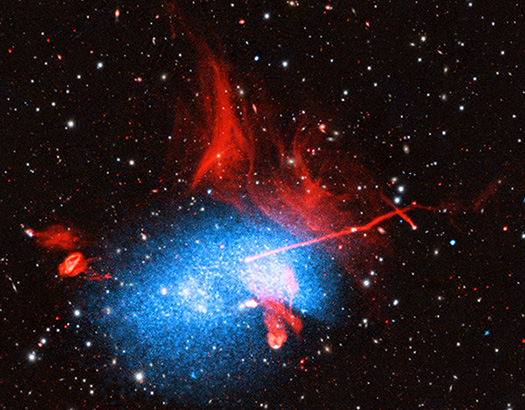
Abell 2256
Credit: X-ray: Chandra: NASA/CXC/Univ. of Bologna/K. Rajpurohit et al.; XMM-Newton: ESA/XMM-Newton/Univ. of Bologna/K. Rajpurohit et al. Radio: LOFAR: LOFAR/ASTRON; GMRT: NCRA/TIFR/GMRT; VLA: NSF/NRAO/VLA; Optical/IR: Pan-STARRS
Astronomers have captured a spectacular, ongoing collision between at least three galaxy clusters. Data from NASA’s Chandra X-ray Observatory, ESA’s (European Space Agency’s) XMM-Newton, and a trio of radio telescopes is helping astronomers sort out what is happening in this jumbled scene. Collisions and mergers like this are the main way that galaxy clusters can grow into the gigantic cosmic edifices seen today. These also act as the largest particle accelerators in the universe.
The giant galaxy cluster forming from this collision is Abell 2256, located 780 million light-years from Earth. This composite image of Abell 2256 combines X-rays from Chandra and XMM in blue with radio data collected by the Giant Metrewave Radio Telescope (GMRT), the Low Frequency Array (LOFAR), and the Karl G. Jansky Very Large Array (VLA) all in red, plus optical and infrared data from Pan-STARRs in white and pale yellow.
NASA's Chandra Finds Galaxy Cluster Collision on a "WHIM"
This image features Abell 98, a system of galaxy clusters that includes a pair in the early stages of a collision. Astronomers have used data from NASA’s Chandra X-ray Observatory (shown as blue and purple with optical data from the WIYN telescope on Kitt Peak in Arizona appearing white and red) to identify key structures and look for “missing” matter in the Universe.
Chandra Adds X-ray Vision to Webb Images
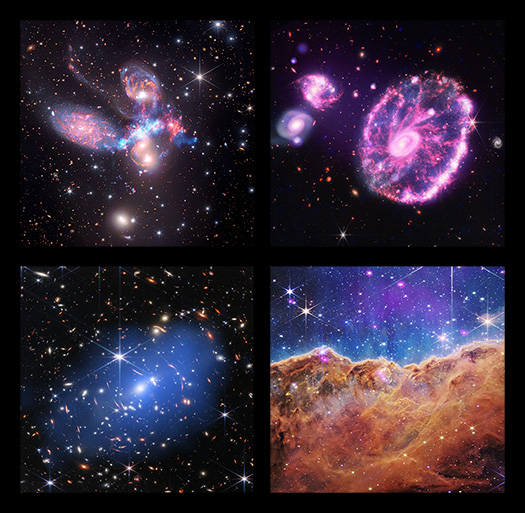
[Upper Left] Stephan's Quintet, [Upper Right] Cartwheel Galaxy,
[Lower Left] SMACS 0723, [Lower Right] The Cosmic Cliffs of the Carina Nebula (NGC 3324)
Credit: X-ray: NASA/CXC/SAO; IR (Spitzer): NASA/JPL-Caltech; IR (Webb): NASA/ESA/CSA/STScI
In the summer of 2022, NASA's James Webb Space Telescope released images from some of its earliest observations with the newly commissioned telescope. Almost instantaneously, these stunning images landed everywhere from the front pages of news outlets to larger-than-life displays in Times Square.
Webb, however, will not pursue its exploration of the universe on its own. It is designed to work in concert with NASA's many other telescopes as well as facilities both in space and on the ground. These new versions of Webb’s first images combine its infrared data with X-rays collected by NASA’s Chandra X-ray Observatory, underscoring how the power of any of these telescopes is only enhanced when joined with others.
NASA Telescopes Capture Stellar Delivery Service for Black Hole
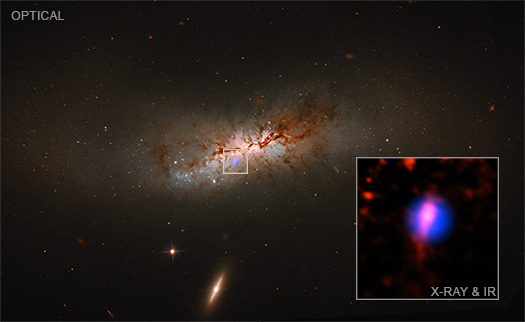
NGC 4424
Credit: X-ray: NASA/CXC/Swinburne Univ. of Technology/A. Graham et al.; Optical: NASA/ESA/STScI
Astronomers may have witnessed a galaxy’s black hole delivery system in action. A new study using data from NASA’s Chandra X-ray Observatory and Hubble Space Telescope outlines how a large black hole may have been delivered to the spiral galaxy NGC 4424 by another, smaller galaxy.
NGC 4424 is located about 54 million light-years from Earth in the Virgo galaxy cluster. The main panel of this image, which has been previously released, shows a wide-field view of this galaxy in optical light from Hubble. The image is about 45,000 light-years wide. The center of this galaxy is expected to host a large black hole estimated to contain a mass between about 60,000 and 100,000 Suns. There are also likely to be millions of stellar-mass black holes, which contain between about 5 and 30 solar masses, spread throughout the galaxy.
Chandra Unveils Rotation Speed of One of the Most Massive Black Holes Ever Seen

Julia Sisk-Reynés
Our guest contributor is Julia Sisk-Reynés, the leader of a new black hole study that is the subject of our latest press release. Julia is a second-year PhD student at the Institute of Astronomy at the University of Cambridge, UK, where she is a member of the X-ray group working mainly with Prof. Chris Reynolds and Dr. James Matthews. Her primary focus is on constraining beyond the Standard Model Physics – in particular, axion-like particles (ALPs)- with X-ray observations of cluster-hosted active galaxies. The team have recently set the tightest limits to-date on the coupling of very light ALPs to electromagnetism with Chandra X-ray observations of the cluster-hosted quasar H1821+643. Julia came to Cambridge in 2020, straight after graduating from the University of Manchester with a master’s degree in physics. Amongst others, she did a project on assessing the sensitivity of the DarkSide-20k liquid argon experiment in Gran Sasso, Italy, to direct dark matter detection.
Black holes are one of the most tantalizing objects in the Universe. By 1915, Einstein’s Theory of General Relativity had introduced the notion that the gravity of black holes is so strong that they can distort the space-time around them … to the point where even light close to the black hole cannot escape! More recently, astronomers have gathered evidence that most – if not all – galaxies emitting lots of light at the center (also called active galactic nuclei or AGN) host a very massive black hole at their core. It is known that the properties of AGN and their central black holes are often linked. For example, the heavier the AGN, the heavier its host black hole. Therefore, the formation, growth, and evolution of black holes over time and their connection with the properties of their host galaxies are fascinating topics for astronomers to pursue.
Astronomers classify black holes into three groups, depending on their mass. Firstly, stellar-mass black holes, thought to form from the gravitational collapse of a star, weigh a few to a few tens of times the mass of the Sun. Then, we have a class of black holes of unknown origin which range from hundreds to tens of thousands of Suns, often referred to as “intermediate mass” black holes. A gravitational wave event detected in 2019 by the LIGO and VIRGO collaborations confirmed the existence of a black hole in this second category. Finally, supermassive Black Holes (SMBHs) weigh between millions and billions of Suns. While their origin is still debated, what we do know is that accretion, that is, the feeding of gas onto such black holes, is responsible for the X-ray emission coming from the AGN that surround them.
Colossal Collisions Linked to Solar System Science
A new study shows a deep connection between some of the largest, most energetic events in the Universe and much smaller, weaker ones powered by our own Sun.
The results come from a long observation with NASA's Chandra X-ray Observatory of Abell 2146, a pair of colliding galaxy clusters located about 2.8 billion light years from Earth. The new study was led by Helen Russell of the University of Nottingham in the United Kingdom.
Galaxy clusters contain hundreds of galaxies and huge amounts of hot gas and dark matter and are among the largest structures in the Universe. Collisions between galaxy clusters release enormous amounts of energy unlike anything witnessed since the big bang and provide scientists with physics laboratories that are unavailable here on Earth.
New NASA Black Hole Sonifications with a Remix
Your browser does not support the video tag.
Credit: X-ray: NASA/CXC/Univ. of Cambridge/C. Reynolds et al.; Sonification: NASA/CXC/SAO/K.Arcand, SYSTEM Sounds (M. Russo, A. Santaguida)
Black Hole at the Center of the Perseus Galaxy Cluster (above)
Since 2003, the black hole at the center of the Perseus galaxy cluster has been associated with sound. This is because astronomers discovered that pressure waves sent out by the black hole caused ripples in the cluster's hot gas that could be translated into a note — one that humans cannot hear some 57 octaves below middle C. Now a new sonification brings more notes to this black hole sound machine. This new sonification — that is, the translation of astronomical data into sound — is being released for NASA's Black Hole Week this year.
In some ways, this sonification is unlike any other done before (1, 2, 3, 4) because it revisits the actual sound waves discovered in data from NASA's Chandra X-ray Observatory. The popular misconception that there is no sound in space originates with the fact that most of space is essentially a vacuum, providing no medium for sound waves to propagate through. A galaxy cluster, on the other hand, has copious amounts of gas that envelop the hundreds or even thousands of galaxies within it, providing a medium for the sound waves to travel.
Feasting Black Holes Caught in Galactic Spiderweb

Spiderweb Galaxy Field
Credit: X-ray: NASA/CXC/INAF/P. Tozzi et al; Optical (Subaru): NAOJ/NINS; Optical (HST): NASA/STScI
Often, a spiderweb conjures the idea of captured prey soon to be consumed by a waiting predator. In the case of the "Spiderweb" protocluster, however, objects that lie within a giant cosmic web are feasting and growing, according to data from NASA's Chandra X-ray Observatory.
The Spiderweb galaxy, officially known as J1140-2629, gets its nickname from its web-like appearance in some optical light images. This likeness can be seen in the inset box where data from NASA's Hubble Space Telescope shows galaxies in orange, white, and blue, and data from Chandra is in purple. Located about 10.6 billion light years from Earth, the Spiderweb galaxy is at the center of a protocluster, a growing collection of galaxies and gas that will eventually evolve into a galaxy cluster.
An Expanse of Light
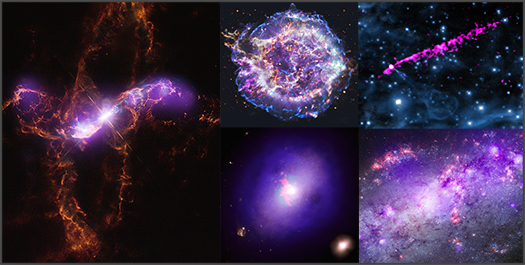
An Expanse of Light
Credit: X-ray: NASA/CXC/SAO; Optical: NASA/STScI, Palomar Observatory, DSS;
Radio: NSF/NRAO/VLA; H-Alpha: LCO/IMACS/MMTF
The recent launches of the James Webb Space Telescope (Webb) and the Imaging X-ray Polarimetry Explorer (IXPE) by NASA and its international partners are excellent reminders that the universe emits light or energy in many different forms. To fully investigate cosmic objects and phenomena, scientists need telescopes that can detect light across what is known as the electromagnetic spectrum.
This gallery provides examples of the ways that different types of light from telescopes on the ground and in space can be combined. The common thread in each of these selections is data from NASA's Chandra X-ray Observatory, illustrating how X-rays — which are emitted by very hot and energetic processes — are found throughout the Universe.


